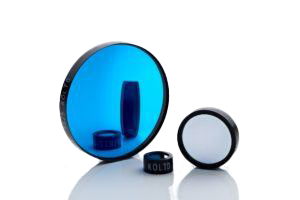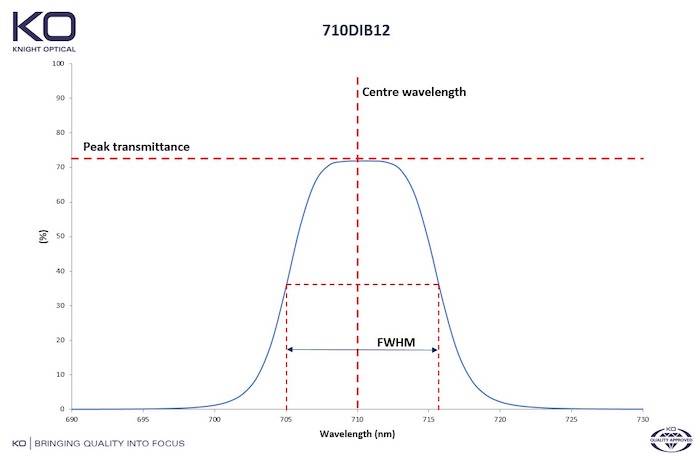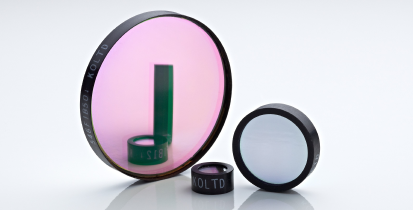

Stock Available
Bespoke Ordering Available
Contact us now
Find out more about our custom interference bandpass filters
Call +44 (0)1622 859444 Call +1 401 583 7846
Interference bandpass filters are excellent for applications requiring specific spectral tolerances. The manufacturing process allows a high level of control on the transmission parameters.
Though we have an extensive stock range of interference bandpass filters, Knight Optical can also provide custom filters manufactured to your specification. We can tailor the spectral properties to meet your application demands including:
- Peak transmission – either as a minimum value, or regulated to perform within a certain range.
- Centre wavelength (CWL) within the UV, visible or infrared waveband.
- Bandwidth or FWHM – we can supply narrowband (< 10nm), standard (10-50nm) and broadband filters (> 50nm).
- Out-of-band blocking – Typically OD4 (T < 0.01%)
Knight Optical can also provide differing dimensions to fit into your application, including mounted and unmounted options. We typically supply 12.5mm, 12.7mm, 25mm, 25.4mm, 50mm, and 50.8mm diameter mounts, which can be etched with your unique batch number if required, however custom mount sizes can also be supplied.Our filters are:
- CNC scribed which involves removing the outer diameter of coating and so enabling a glass-to-glass epoxy seal, rather than a glass-to-coating seal, which provides an excellent barrier against moisture.
- If mounted, they are hermetically sealed to further protect against moisture and there increase the long-term stability.
You can find our typical manufacturing capabilities below, however, please enquire for further information. Please note, the spectral properties are dependent on factors such as the design wavelength and bandwidth size.
Explore the variety of filters Knight Optical provides:

Speak to our experts about your Custom Interference Bandpass Filters needs today
Call +44 (0)1622 859444 Call +1 401 583 7846Make a quick enquiry about Custom Interference Bandpass Filters Now
Dive into the forefront of optical solutions. Got questions about an optical product? Reach out now and let our expertise guide you.
Optical Properties of Interference Bandpass Filters
You can find our typical manufacturing capabilities below, however, please enquire for further information. Please note, the spectral properties are dependent on factors such as the design wavelength and bandwidth size.
| Diameter | 5mm to 100mm+ |
|---|---|
| Centre wavelength (CWL) | 200nm to 3000nm+ |
| Bandwidth (FWHM) | 3nm to 100nm+ |
|---|---|
| Temperature limits | -50°C to 80°C |

Frequently Asked Questions
-
What is an interference bandpass filter, and how does it work?
-
An interference bandpass filter is a type of optical filter that allows a specific range of wavelengths to pass through while blocking others outside this range. It operates on the principle of optical interference, using multiple layers of thin films to constructively and destructively interfere with incoming light. This process isolates a narrow band of wavelengths, making these filters ideal for applications requiring precise spectral selection, such as scientific research, telecommunications, and optical instrumentation.
-
How is an infrared bandpass filter utilised in optical systems?
-
Infrared bandpass filters are designed to selectively transmit infrared wavelengths while blocking visible light and other parts of the spectrum. These filters are crucial in applications such as thermal imaging, night vision equipment, and infrared spectroscopy, where isolating specific infrared wavelengths enhances the performance of the system by providing clearer images or more accurate spectral data, allowing for detailed analysis and observation.
-
What are the common uses of bandpass filters in technology and research?
-
Bandpass filters find extensive applications across various fields, including scientific research, particularly in spectroscopy and laser systems, to filter out unwanted wavelengths; and in photography and imaging, to enhance contrast or isolate specific light for creative effects. They’re also pivotal in medical imaging and diagnostics, where precise wavelength selection can lead to better imaging contrast and clarity.
-
Can you explain how bandpass filters differ from notch filters?
-
Bandpass filters and notch filters are opposites in their function. While a bandpass filter allows a specific range of wavelengths to pass and blocks those outside this range, a notch filter does the reverse by blocking a specific range of wavelengths and allowing those outside this range to pass. This makes bandpass filters ideal for applications requiring a narrow spectral window, whereas notch filters are used when a specific wavelength range needs to be eliminated, such as in laser protection or noise reduction in signals.
-
Why are optical bandpass filters important in imaging and spectroscopy?
-
Optical bandpass filters play a crucial role in imaging and spectroscopy by allowing only a selected range of wavelengths to reach the detector, thereby improving the quality of the image or the spectral data. In imaging, this can mean sharper, more defined images with reduced background noise. In spectroscopy, using bandpass filters can significantly enhance the detection of specific spectral lines or features by filtering out unwanted light, leading to more accurate and sensitive measurements.
-
How do interference bands contribute to the functionality of bandpass filters?
-
Interference bands are the result of the constructive and destructive interference of light waves when they reflect off the multiple thin-film layers of a bandpass filter. These bands define the specific wavelengths that the filter will transmit, based on the thickness and composition of the layers. By precisely controlling these parameters, manufacturers can design filters with very specific transmission properties, allowing for the creation of highly selective bandpass filters that can target very narrow ranges of wavelengths for various scientific, industrial, and technological applications.
Is your question not here?
We are ready and waiting to answer any queries you may have about interference bandpass filters.
Additional Information
Manufacturing Process
Interference filters are manufactured by depositing layers of material (usually a metal or dielectric material), with differing refractive indices and thickness, on to a glass substrate.
Customisable Behaviour
The incident light will behave differently at each layer, due to interference, and ultimately only the desired wavelengths will exit the filter.
Multiple Substrate Stacks
Often multiple stacks of these coated substrates, separated by a dielectric spacer layer (filter cavity), are needed to get the desired wavelength and steep slope. One filter can often include 3-7 cavities.
Bandwidth and Transmission
Centre wavelength (CWL) is the midpoint of the bandwidth. Peak transmission is the maximum transmission achieved. Full width-half maximum (FWHM) defines the bandwidth of which the filter will transmit – half of the peak transmission will define the minimum and maximum limits of the bandwidth.
Blocking Bands
Either side of the transmission band there are blocking bands (or out-of-band blocking), usually specified as an OD value.
Quality Assurance
Transmission Verification
Using our Agilent Cary 5000 spectrophotometer we verify the peak transmission, centre wavelength and FWHM, as well as the out-of-band blocking (OD). For infrared bandpass filters, we use our Agilent Cary 660 FTIR to check the transmission.
Raw Transmission Data
We are able to provide the transmission data as raw ASCII (.csv) files or present it as a graph.
Verified Dimensions
Dimensions are verified with handheld measuring devices, typically our micrometres.
Visual Inspection
All filters are visually inspected by our QA department prior to packaging.

Get in touch with us:
With our in-house state-of-the-art metrology laboratory you can be confident that your optical components will meet your requirements. You can find out more about our testing facilities here.

Operating for over 30 years
Knight Optical has been operating for over 30 years, with our managing director Colin Overton at the helm. Over this time, we have become a global leader in the production and distribution of scientific optical components and bringing quality into focus for all of our products and services that we provide.
Our 2022/2023 Catalogue
Inside Knight Optical’s catalogue you’ll find details of the industries we serve as well as the many other services we can offer. It also showcases hundreds of our most popular products, supported by useful technical information, to help you choose the right part for your application.
Click below to view our digital catalogue now.


